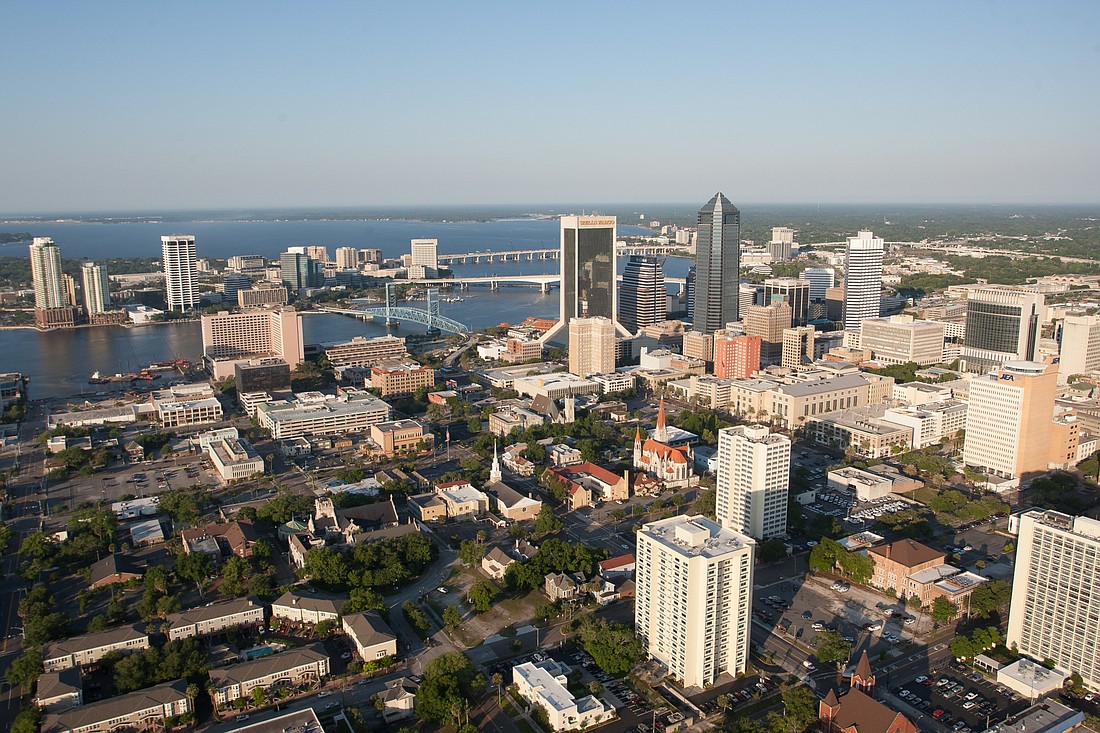
By Dave Chauncey • Young Lawyers Section treasurer
The Downtown Investment Authority has put forth a plan to invest in adaptive reuse of Jacksonville’s most historic buildings. It is a plan that makes economic sense and should be supported.
In 1901, the city burned to the ground and nearly 2,400 structures were destroyed. From the ashes, people from all walks of life rebuilt their lives and this city.
Sadly, over the past 50 years, many of the historic buildings Downtown that provided a glimpse into its resurgence more than a century ago were demolished.
It was not long ago that Main Street was lined with historic buildings from the Main Street Bridge all the way to Springfield.
Bay, Forsyth, Adams and Ashley streets were dense and walkable with entertainment and business.
Although times change, and evolution with market demands is a must, the demolition of sound structures has left Downtown filled with a patchwork of vacant lots and surface parking spaces.
If you stand at the corner of Laura and Adams streets, you can almost feel the former glory of Downtown with its architecture, hotels, apartments and offices.
In 2016, there was a step in a positive direction when City Council voted to create a Downtown Historic District on the National Register of Historic Places.
We still are blessed with some remaining historic stock in buildings worth preserving and reusing. Historic structures often are more architecturally significant while providing a shared sense of place and identity. Most historic structures cannot be replicated except at exorbitant cost.
Without a doubt, some buildings are so dilapidated and costly to reuse that they must come down. Likewise, there are buildings that outlive their usefulness or there is a higher and better utilization.
The economics of preservation and adaptive reuse tell us that rather than the city investing millions of dollars into demolitions, that rarely are in response to actual market conditions, it should reinvest in its historic buildings as the DIA plan provides.
In 2002, Tim McLendon, who I worked for as a research assistant at the University of Florida Center for Governmental Responsibility while a law student, co-authored a state-commissioned study concerning the economic impact of historic preservation and adaptive reuse in Florida.
The study quantified the impact of preservation and reuse at $4.2 billion per year. For example, nearly 60% of tourists said they want to visit a historic district or site while visiting Florida.
The study discussed the preservation and reuse efforts in Springfield in the late 1990s spearheaded by then-Mayor John Delaney that helped property values double in only a few years.
Property values in Springfield continue to skyrocket, which has positively impacted the city’s bottom line. Other local historic neighborhoods have seen similar results.
St. Johns County was held up as an exemplar by the study after decades worth of preservation and reuse efforts reaped economic success.
Texas and Utah conducted similar studies that found that for every state dollar invested in reuse, there was at least $4 of private sector investment.
You do not have to go far to see other successes. Known for years as “God’s Waiting Room” with little to no development, Downtown St. Petersburg has been revived with a mix of reuse and infill development. Orlando, Sarasota, Savannah and Greenville, South Carolina, are a few regional successes.
Jacksonville has failed to see a new high-rise built on its Northbank since The Plaza Condominium at Berkman Plaza & Marina in 2002.
However, we have seen preservation and reuse succeed with the restorations of historic high rises such as The Barnett Building, The Carling, and 11 East Forsyth that are currently at or near capacity in tenants. These buildings were provided a new life through the Historic Preservation Trust Fund that was established in 2002 but currently has no funds available.
Home runs, like the plans discussed at the Shipyards (which will require a lot of government subsidy), would be progress if they happen but, to use another baseball analogy, we need to also keep hitting singles and doubles with complementary uses that keep momentum going. Eventually, we will score a lot of home runs including new infill development as the market works.
Historic preservation and reuse is an essential part of revitalizing an urban core. The DIA’s plan is well crafted as it seeks to invest in historic preservation while helping developers through nonmonetary means by streamlining the bureaucratic regulatory process.
There are several projects in the works such as the former Ambassador Hotel, former JEA/Independent Life Building, and the Laura Street Trio that can support momentum with a hopeful economic resurgence.
The plan will help revitalize Downtown while preserving historic sites for us and future generations.
Dave Chauncey is an attorney at Alexander DeGance Barnett and chair of the Jacksonville Historical Society Historic Sites Committee.